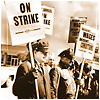Learn About the U.S. > Work and Workplaces in the U.S. > Labor Unions > Important U.S. Labor Leaders: George Meany

|

Labor Unions
- U.S. Labor Unions in the 1940s
- U.S. Unions in the Cold War
- Public worker unions in the United States
- Decline in Strike Activity in the US
- Union Membership Across the United States
- Right-to-Work Laws
- Types of Unions in the United States
- The AFL-CIO
- Labor Contracts in the United States
- Strikes in the United States
- What Happens During a Strike
- Long Strikes and Violence
- The 1964 Civil Rights Act
- Union Campaign Contributions and Political Influence
- Unions and Politics
- U.S. Unions in the 90s and Today
- Important U.S. Labor Leaders: George Meany
- Important U.S. Labor Leaders: John L. Lewis
- Important U.S. Labor Leaders: Walter Reuther
- Important U.S. Labor Leaders: A. Philip Randolph
- Important U.S. Labor Leaders: Jimmy Hoffa
- Important U.S. Labor Leaders: Caesar Chavez
|

George Meany was involved with numerous unions throughout his lifetime.
Photo from Spartacus Educational.
Important U.S. Labor Leaders: George Meany
George Meany began his career in union leadership in 1920, when he became the youngest president of the local chapter of the Association of Plumbers and Pipefitters in New York City. In 1934 Meany became president of the New York State Federation of Labor and built a strong political organization in America’s most populous state. By 1939 he had become secretary-treasurer of the national American Federation of Labor (AFL) and an influential player in both the national labor movement and national politics. In 1952, AFL members elected George Meany their president. He then focused his attention on unifying much of the labor movement by bringing about the merger of the AFL with the CIO (Congress of Industrial Organizations), another huge labor federation. The two federations merged in 1955, forming the AFL-CIO. Meany was unanimously elected president of the newly merged labor federation. Over the years Meany built the AFL-CIO into a powerful organization that did much to improve the lives of its members. Under his leadership the federation actively pushed Congress to pass major civil rights laws. It also lobbied for social programs such as Medicare. During his twenty-five year leadership of the AFL-CIO, George Meany was a staunch supporter of human and civil rights in the United States and around the world. He retired as president of the federation in 1979 and died in 1980.
|
Special Terms:
Teamsters Union
|
| Download Podcast in
English
| Japanese
|
|
Document |
Audio-Video |
Chart |
Picture |
Map
|
|

